
Publisher:
Bonnie King
CONTACT:
Newsroom@Salem-news.com
Advertising:
Adsales@Salem-news.com

~Truth~
~Justice~
~Peace~
TJP
Aug-01-2006 22:30

 TweetFollow @OregonNews
TweetFollow @OregonNews
OSU Researchers: Recurring Dead Zone Off Oregon is Spreading
Salem-News.comThis year for the first time, the effect of the low-oxygen zone is also being seen in coastal waters off Washington, researchers at OSU and the Olympic Coast National Marine Sanctuary indicate.
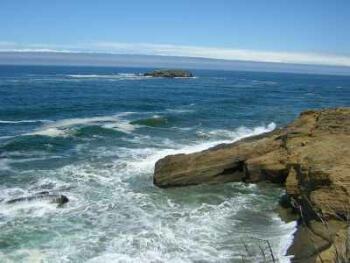 Various photos courtesy: OSU, shiftingbaselines.org, earthdive.com, blogs.chron.com, |
(CORVALLIS) - A hypoxic “dead zone” has formed off the Oregon Coast for the fifth time in five years, according to researchers at Oregon State University.
A fundamental new trend in atmospheric and ocean circulation patterns in the Pacific Northwest appears to have begun, scientists say, and apparently is expanding its scope beyond Oregon waters.
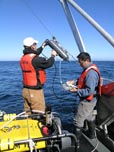 There have been reports of dead crabs stretching from the central Oregon coast to the central Washington coast. Some dissolved oxygen levels at 180 feet have recently been measured as low as 0.55 milliliters per liter, and areas as shallow as 45 feet have been measured at 1 milliliter per liter.
These oxygen levels are several times lower than normal, and any dissolved oxygen level below 1.4 milliliters per liter is hypoxic, capable of suffocating a wide range of fish, crabs, and other marine life.
"There is a huge pool of low-oxygen water off the central Oregon coast with values as low as 0.46 milliliters per liter,” said Francis Chan, marine ecologist in the OSU Department of Zoology and with the Partnership for Interdisciplinary Studies of Coastal Oceans (PISCO), a marine research consortium at OSU and other universities along the West Coast.
There have been reports of dead crabs stretching from the central Oregon coast to the central Washington coast. Some dissolved oxygen levels at 180 feet have recently been measured as low as 0.55 milliliters per liter, and areas as shallow as 45 feet have been measured at 1 milliliter per liter.
These oxygen levels are several times lower than normal, and any dissolved oxygen level below 1.4 milliliters per liter is hypoxic, capable of suffocating a wide range of fish, crabs, and other marine life.
"There is a huge pool of low-oxygen water off the central Oregon coast with values as low as 0.46 milliliters per liter,” said Francis Chan, marine ecologist in the OSU Department of Zoology and with the Partnership for Interdisciplinary Studies of Coastal Oceans (PISCO), a marine research consortium at OSU and other universities along the West Coast.
 “OSU researchers have documented this year’s region of low-oxygen bottom waters from Florence to Cascade Head,” Chan said. “The lack of consistent upwelling winds allowed a low-oxygen pool of deep water to build up. Now that the upwelling-favorable winds are blowing consistently, we’re seeing that pool of water come close to shore and begin to suffocate marine life. If these winds continue to blow, we expect to see continued and possibly significant die-offs.”
As events such as this become more regular, researchers say, they appear less like an anomaly and more like a fundamental shift in marine conditions and ocean behavior. In particular, a change in intensity and timing of coastal winds seems to play a significant role in these events.
"We're seeing wild swings from year to year in the timing and duration of winds favorable for upwelling,” said Jack Barth, an oceanographer with PISCO and the OSU College of Oceanic and Atmospheric Sciences. “This change from normal seasonal patterns and the increased variability are both consistent with climate change scenarios."
“OSU researchers have documented this year’s region of low-oxygen bottom waters from Florence to Cascade Head,” Chan said. “The lack of consistent upwelling winds allowed a low-oxygen pool of deep water to build up. Now that the upwelling-favorable winds are blowing consistently, we’re seeing that pool of water come close to shore and begin to suffocate marine life. If these winds continue to blow, we expect to see continued and possibly significant die-offs.”
As events such as this become more regular, researchers say, they appear less like an anomaly and more like a fundamental shift in marine conditions and ocean behavior. In particular, a change in intensity and timing of coastal winds seems to play a significant role in these events.
"We're seeing wild swings from year to year in the timing and duration of winds favorable for upwelling,” said Jack Barth, an oceanographer with PISCO and the OSU College of Oceanic and Atmospheric Sciences. “This change from normal seasonal patterns and the increased variability are both consistent with climate change scenarios."
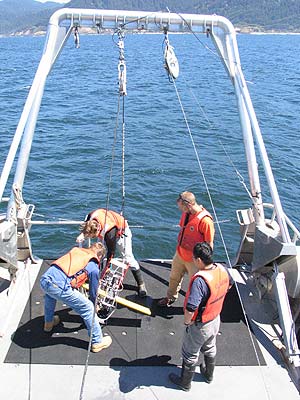 Barth and his colleagues are working on new circulation models that may allow scientists to predict when hypoxia and these “dead zones” will occur. No connection has been observed between these events and other major ocean cycles, such as El Niño or the Pacific Decadal Oscillation.
The lack of wide-scale ocean monitoring makes determining the size and movement of the dead zone difficult, although some new instrumentation being used this year by OSU scientists is helping. Dissolved oxygen sensors have been deployed on the sea floor both close to shore and in 260 feet of water off Newport, some of which are sending data in near real-time.
In addition, a new underwater unmanned vehicle equipped with sensors to measure temperature, salinity, chlorophyll and dissolved oxygen is routinely sampling across central Oregon waters.
During normal years, cold water rich in nutrients but low in oxygen upwells from the deep ocean off Oregon, mixes with oxygen-rich water near the surface, causes some phytoplankton growth and provides the basis for a thriving fishery and healthy marine food chain. During dead zone periods, some of the normal processes – including wind and current conditions – can change. This allows huge masses of plant growth to die, decay and in the process consume even more of the available oxygen near the sea floor, causing hypoxic conditions for marine life.
The first event in 2002 caused a massive die-off of fish and invertebrate marine species on the central Oregon coast. Less severe and somewhat different events occurred in 2003, 2004 and 2005.
Barth and his colleagues are working on new circulation models that may allow scientists to predict when hypoxia and these “dead zones” will occur. No connection has been observed between these events and other major ocean cycles, such as El Niño or the Pacific Decadal Oscillation.
The lack of wide-scale ocean monitoring makes determining the size and movement of the dead zone difficult, although some new instrumentation being used this year by OSU scientists is helping. Dissolved oxygen sensors have been deployed on the sea floor both close to shore and in 260 feet of water off Newport, some of which are sending data in near real-time.
In addition, a new underwater unmanned vehicle equipped with sensors to measure temperature, salinity, chlorophyll and dissolved oxygen is routinely sampling across central Oregon waters.
During normal years, cold water rich in nutrients but low in oxygen upwells from the deep ocean off Oregon, mixes with oxygen-rich water near the surface, causes some phytoplankton growth and provides the basis for a thriving fishery and healthy marine food chain. During dead zone periods, some of the normal processes – including wind and current conditions – can change. This allows huge masses of plant growth to die, decay and in the process consume even more of the available oxygen near the sea floor, causing hypoxic conditions for marine life.
The first event in 2002 caused a massive die-off of fish and invertebrate marine species on the central Oregon coast. Less severe and somewhat different events occurred in 2003, 2004 and 2005.
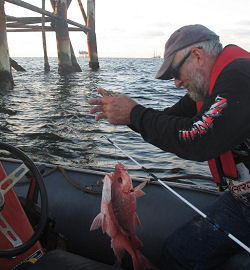 The 2006 “dead zone” has a wider north-south extent. Some crabbers in the central Washington coast reported all dead crabs in pots at depths of about 45-90 feet, north of the Moclips River. Large numbers of dead Dungeness crab have been reported on the beach as far north as Kalaloch. Numerous species of bottom fish have been found dead on the beach south of the Quinault River in Washington.
In Oregon, the most vulnerable area in recent years has been the central third of the coast between about Newport and Florence, where conditions seem to be conducive to the development of low-oxygen waters. It’s not always easy to measure the biological impact of the dead zones, because many dead animals may be washed out to the deep sea. But researchers say that this year’s event may ultimately be as severe as the first one in 2002, although it reflects slightly different wind and ocean current conditions.
The 2006 “dead zone” has a wider north-south extent. Some crabbers in the central Washington coast reported all dead crabs in pots at depths of about 45-90 feet, north of the Moclips River. Large numbers of dead Dungeness crab have been reported on the beach as far north as Kalaloch. Numerous species of bottom fish have been found dead on the beach south of the Quinault River in Washington.
In Oregon, the most vulnerable area in recent years has been the central third of the coast between about Newport and Florence, where conditions seem to be conducive to the development of low-oxygen waters. It’s not always easy to measure the biological impact of the dead zones, because many dead animals may be washed out to the deep sea. But researchers say that this year’s event may ultimately be as severe as the first one in 2002, although it reflects slightly different wind and ocean current conditions.
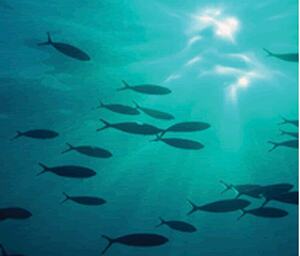 Collaborating on this research are scientists from OSU, PISCO, the Oregon Department of Fish and Wildlife, National Oceanic and Atmospheric Administration, University of Washington and the Olympic Coast National Marine Sanctuary.
Researchers say that it’s difficult to tell what long-term ecological impacts these dead zone events may have on marine ecosystems.
“Many marine species live in fairly specialized ecological niches and any time you change the fundamental physics, chemistry and nature of the system, it’s a serious concern,” Barth said.
Jane Lubchenco, the Valley Professor of Marine Biology at OSU and principle investigator for PISCO, also said that the biological monitoring of species health and impacts in the nearshore Pacific Ocean is “grossly inadequate,” making it difficult to evaluate the long-term impacts of low-oxygen and other events
Collaborating on this research are scientists from OSU, PISCO, the Oregon Department of Fish and Wildlife, National Oceanic and Atmospheric Administration, University of Washington and the Olympic Coast National Marine Sanctuary.
Researchers say that it’s difficult to tell what long-term ecological impacts these dead zone events may have on marine ecosystems.
“Many marine species live in fairly specialized ecological niches and any time you change the fundamental physics, chemistry and nature of the system, it’s a serious concern,” Barth said.
Jane Lubchenco, the Valley Professor of Marine Biology at OSU and principle investigator for PISCO, also said that the biological monitoring of species health and impacts in the nearshore Pacific Ocean is “grossly inadequate,” making it difficult to evaluate the long-term impacts of low-oxygen and other events
Articles for July 31, 2006 | Articles for August 1, 2006 | Articles for August 2, 2006


Salem-News.com:


googlec507860f6901db00.html
Terms of Service | Privacy Policy
Comments are Closed on this story.
[Return to Top]
©2025 Salem-News.com. All opinions expressed in this article are those of the author and do not necessarily reflect those of Salem-News.com.